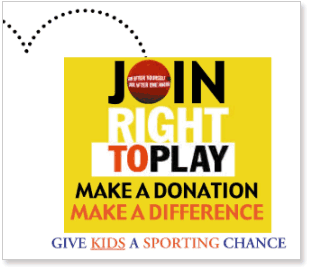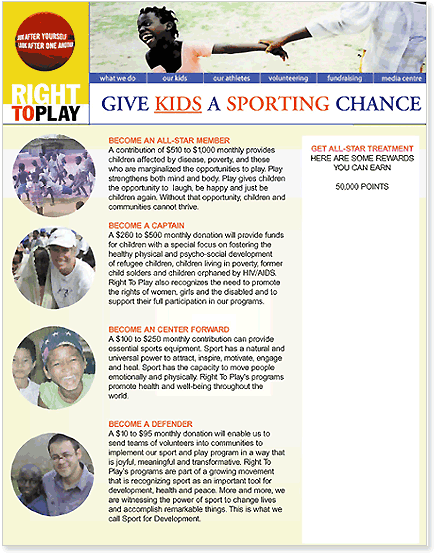|
Four Challenges and Solutions to Creating an Effective Online Fundraising Campaign by Michael Johnston, President, HJC New Media and Billy Sharma, Creative Director, HJC New Media Many nonprofits are beginning to understand and tap into the power of the Internet for raising funds. However, as they venture from traditional direct mail solicitations to online fundraising, organizations must tackle four key challenges to create effective online campaigns:
Consider the example of Right To Play (http://www.righttoplay.com/), a nonprofit group addressing these critical issues in an online campaign plan that is in progress. Based in Canada, Right To Play is a humanitarian organization that uses specially designed sport and play programs to encourage the healthy physical, social and emotional development of the world’s most disadvantaged children. Since 60 to 70 percent of any direct marketing initiative’s success hinges on reaching the right people, the first priority for the organization’s general online fundraising campaign has been sifting out inappropriate people to target. Right To Play needs to:
The organization is working with HJC New Media, a consulting firm focused on fundraising and communications, to develop a marketing plan that addresses the four key challenges listed above. The firm has recommended specific groups for the campaign plan, targeting the soccer, baseball and hockey leagues in Canada that were likely to be full of “soccer moms,” “hockey dads” and “adult participants.” These groups not only value the importance of sports, but many parents also are willing to sacrifice time and money so their can children play. These groups would be more sympathetic to Right To Play’s initiatives. Additionally, these groups include net-savvy, middle-aged and older couples. Many have children later in life and, often, both parents work so they have more disposable income, making them better prospects for donating. In addition, each province in Canada has its own leagues run by volunteers who manage schedules, team standings and contact with parents or participants. These volunteers primarily interact electronically with parents and participants via email or postings on Web sites, so the parents are primed for making Internet donations. To deal with the authorization challenge, the campaign plan will ensure that the league managers, who typically are amenable to helping nonprofits with a strong link to sports, make the initial contact. They relay the messages to their team members and get them to log on to Right To Play’s Web site. By approaching donors through league managers, the organization is more likely to get its messages read because donors are more inclined to respond to a friend than to an organization. Addressing the challenges of attraction and motivation, HJC recommended offering two incentives to prospects to make donating more attractive:
After addressing these challenges, Right To Play’s campaign plan includes developing and posting Web content with a clear donation focus and a strong emotional appeal. The first priority is establishing a prominent donation presence so that site visitors can easily find where to go to donate. To create an eye-catching donation graphic without altering the home page layout radically, HJC suggested including a campaign logo with a striking, animated visual element where a ball bounces into the campaign logo, coming to rest inside the “join” button as if it had landed in a basketball net. To heighten emotional impact, the donation page Web content would include audio and video elements. Images of happy children playing, with the sound of their laughter, would set the mood before the appeal. True heartwarming stories from field volunteers also would help create a stronger plea.
Fig. 2: The donation page includes powerful images and continues the
Michael Johnston is president of HJC New Media, a one-stop consulting service covering fundraising and new media communications. Billy Sharma is creative director at HJC New Media. For more information about HJC New Media, visit http://www.hjcnewmedia.com/ Have a colleague who might be interested in this topic? Why not forward this article?
|
|





